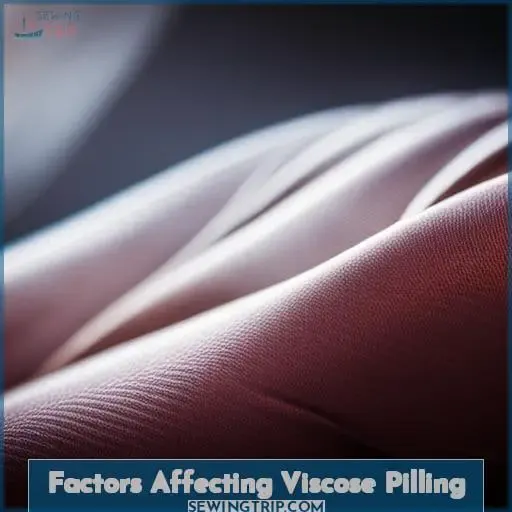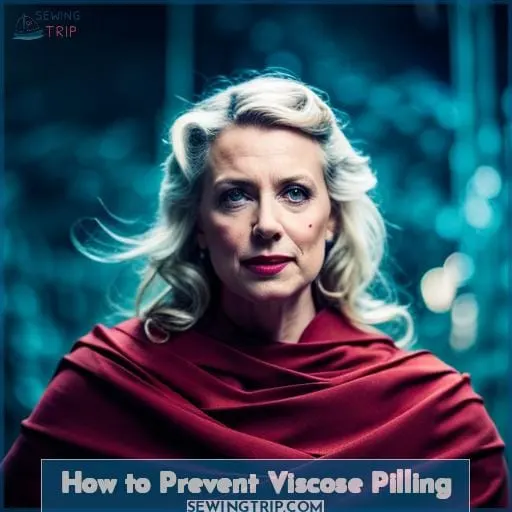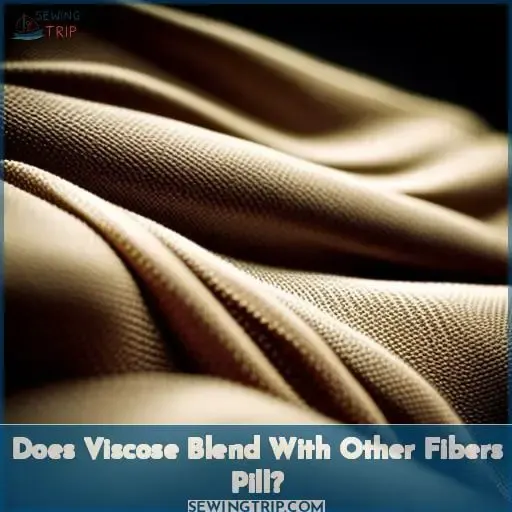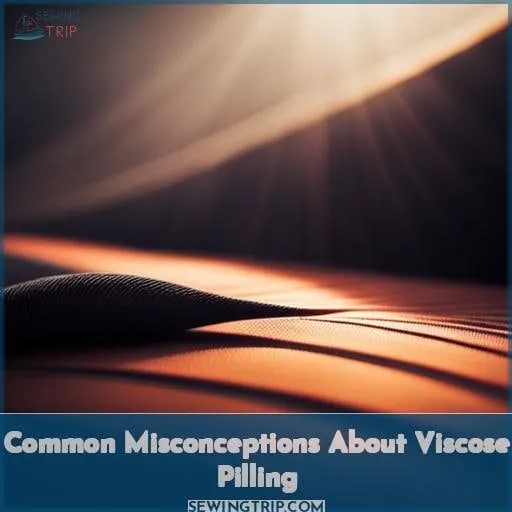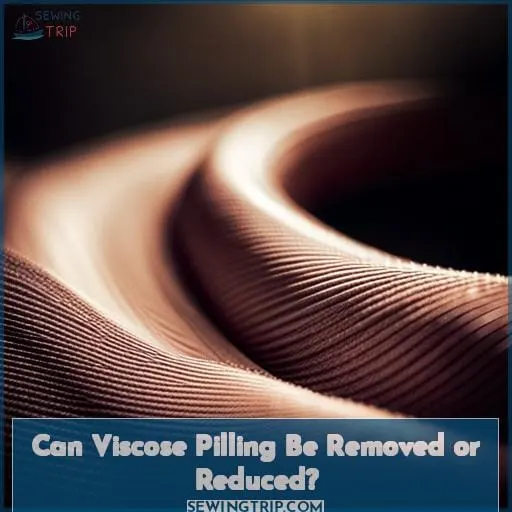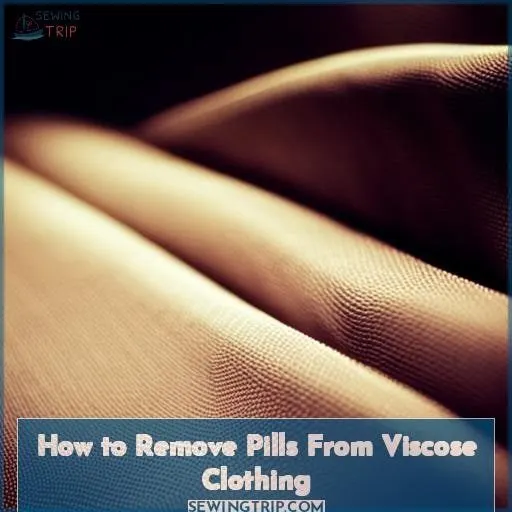This site is supported by our readers. We may earn a commission, at no cost to you, if you purchase through links.
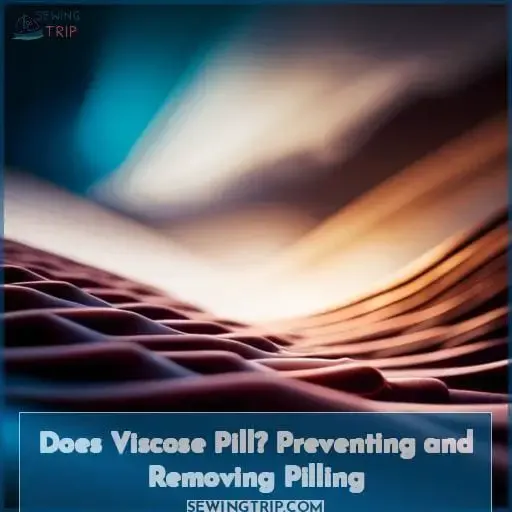 Discover the truth about viscose pilling and how you can prevent and remove those pesky fuzz balls from your favorite clothing.
Discover the truth about viscose pilling and how you can prevent and remove those pesky fuzz balls from your favorite clothing.
Does viscose pill? Find out what causes it, factors that affect pilling, and common misconceptions.
Learn valuable tips on preventing pilling, choosing high-quality fabrics, and following proper care instructions.
Plus, explore effective methods for removing pills from viscose garments.
Say goodbye to unsightly pills with these practical solutions for a smoother wardrobe experience!
Table Of Contents
- Key Takeaways
- What Causes Viscose to Pill?
- Factors Affecting Viscose Pilling
- How to Prevent Viscose Pilling
- Does Viscose Blend With Other Fibers Pill?
- Common Misconceptions About Viscose Pilling
- Can Viscose Pilling Be Removed or Reduced?
- How to Remove Pills From Viscose Clothing
- Are There Pill-Resistant Viscose Fabrics?
- Best Practices for Buying Viscose Clothing
- Alternatives to Viscose for Pill-Resistant Fabrics
- Frequently Asked Questions (FAQs)
- Conclusion
Key Takeaways
- Viscose fabrics can pill due to factors such as fiber quality, friction, fabric composition, and care practices.
- Blending viscose with other fibers does not guarantee no pilling.
- Alternatives to viscose, such as modal, bamboo, and Tencel, may also be prone to pilling.
- Manual removal methods, using tools like fabric shavers, and prevention through choosing pill-resistant fabrics are effective ways to deal with pilling in viscose clothing.
What Causes Viscose to Pill?
Viscose, a type of rayon made from wood pulp, is prone to pilling due to its structure and characteristics.
The fibers in viscose tend to be shorter and more brittle than other fabrics, causing them to break easily and form pills on the surface of the fabric.
Additionally, friction from rubbing against other surfaces can also contribute to pilling.
Understanding these causes can help you take preventative measures and choose proper care techniques for your viscose garments.
Viscose pilling causes?
Viscose pilling occurs due to friction and abrasion on the fabric’s surface. Factors that contribute to viscose pilling include:
- Fiber composition
- Fabric construction
- Care and maintenance
Misconceptions surrounding viscose pilling may lead to confusion about prevention and removal methods. Understanding these causes will help you prevent and remove unsightly pills from your viscose garments effectively.
Preventing viscose pilling?
To prevent pilling in viscose clothing, take measures to preserve garment quality.
- Choose high-quality viscose fabrics and follow care instructions.
- Use fabric softener or conditioner during washing.
- Be cautious when wearing cross-body bags or jackets with stiff linings.
- Remove pills manually or use fabric shavers/ electric lint removers for effective de-pilling of viscose garments.
How to remove pilling?
To remove pilling from viscose clothing, you can use various methods and tools to effectively restore the fabric’s smooth appearance.
- Gently rub a fabric comb or stone over the affected areas.
- Use an electric lint remover or fabric shaver for larger pills.
- Consider professional de-pilling services for stubborn pilling on delicate viscose sweaters.
Factors Affecting Viscose Pilling
When it comes to the factors affecting viscose pilling, fiber composition plays a crucial role.
Viscose blends that contain a higher percentage of natural fibers tend to have less pilling compared to those with more synthetic fibers.
Additionally, fabric construction and the way the garment is cared for and maintained can also contribute to its tendency to pill.
Fiber Composition
When considering factors that affect viscose pilling, it’s important to examine the fiber composition.
The type of fibers used in a fabric can greatly impact its tendency to pill. Natural fabrics like cotton and wool are less prone to pilling compared to man-made fibers such as polyester or nylon.
Here is a table highlighting the different fiber compositions and their effect on viscose pilling:
| Fiber Composition | Pilling Tendency |
|---|---|
| Cotton | Low |
| Wool | Low |
| Silk | Medium |
| Polyester | High |
Understanding the fiber composition of your clothing can guide you in making fabric choices that are less likely to pill and require fewer removal methods for maintaining their appearance over time.
Fabric Construction
When it comes to fabric construction, several factors can affect the pilling of viscose garments.
The way the fibers are woven together and the density of the fabric play a significant role in preventing or promoting pilling.
Additionally, certain blends with synthetic fibers may increase friction and contribute to more pill formation.
Understanding these aspects is crucial for enhancing garment durability and reducing unwanted pills on your viscose clothing.
Care and Maintenance
Taking proper care of your viscose clothing is essential in preventing and reducing pilling.
To maintain the quality of your garments, avoid using fabric softeners as they can weaken the fibers and increase the likelihood of pilling.
Instead, opt for gentle detergents specifically designed for delicate fabrics like viscose.
Additionally, consider investing in a fabric shaver to remove any pills that may develop over time.
How to Prevent Viscose Pilling
To prevent viscose pilling, it’s crucial to choose high-quality fabrics made of viscose.
Look for garments that have a higher percentage of natural fibers blended with the viscose.
Follow proper care instructions by washing your clothing on a gentle cycle and avoiding harsh detergents or bleach.
Additionally, using fabric softener or conditioner can help reduce friction and minimize pilling.
Choose High-Quality Viscose Fabrics
To prevent pilling on your viscose clothing, choose high-quality fabrics.
Look for options that have strong stitching and are made from synthetic blends or natural fibers like cotton or wool.
Pay attention to the fabric weave and follow care instructions carefully to maintain the quality of your viscose garments and stop pilling from occurring.
Follow Proper Care Instructions
To prevent pilling on viscose fabrics, follow care instructions meticulously.
Machine wash your viscose garments in a gentle cycle with cold water and mild detergent.
Avoid using bleach or harsh chemicals that can weaken the fibers.
Additionally, consider turning the clothing inside out before washing to minimize friction.
Proper care will help maintain the integrity of your viscose fabric and reduce the risk of pilling.
Use Fabric Softener or Conditioner
To prevent pilling on your viscose clothing, use fabric softener or conditioner during the washing process.
Fabric softeners help to lubricate the fibers and reduce friction, preventing them from rubbing against each other and forming pills.
Conditioners also add moisture to the fabric, making it less prone to pilling.
Incorporating these steps into your viscose care routine will help keep your garments looking smooth and pill-free.
Does Viscose Blend With Other Fibers Pill?
When it comes to the issue of pilling, you may wonder if viscose blended with other fibers is prone to this problem. Viscose blending can affect the durability and pill-resistance of a fabric. The choice of fabric combinations plays a significant role in determining whether or not pilling will occur.
Some blends that include viscose may be more susceptible to pilling due to factors such as fasteners, cost-cutting measures, and lower-quality materials used in production.
It’s important to consider blend considerations when purchasing clothing made from viscose blends. Brands known for their trustworthiness and commitment to quality are more likely to use higher-grade materials and construction techniques that minimize the risk of pilling.
To avoid potential issues with excessive pilling, it’s recommended that consumers pay attention not only to the percentage of viscose in a blend but also assess other aspects such as fastener quality, stitching integrity, overall garment design detail,and brand reputation before making a purchase decision.
Common Misconceptions About Viscose Pilling
Don’t fall for these common misconceptions about viscose pilling.
- Reality: While it’s true that some fibers are more prone to pilling than others, including viscose, it doesn’t mean that all viscose fabrics are immune to pilling. Pill formation can still occur with regular wear and washing.
-
Misconception: Blend fabrics don’t pill as much as pure viscose.
- Reality: Blending other fibers with viscose may reduce the likelihood of pilling to some extent, but it doesn’t guarantee complete prevention. The presence of synthetic or natural blends in a fabric doesn’t eliminate the risk of blend pilling.
-
Misconception: There are no alternatives to viscose.
- Reality: There are many other fabrics that are just as soft and comfortable as viscose, but don’t pill as easily. Some popular alternatives to viscose include modal, bamboo, and tencel.
Can Viscose Pilling Be Removed or Reduced?
You can remove or reduce pilling on viscose clothing.
Pilling is a common issue with many fabrics, including viscose. However, there are steps you can take to improve the appearance of your garments and minimize pilling.
To begin with, manual removal methods such as using a fabric comb or stone can help get rid of pills on the surface of your clothing. Additionally, fabric shavers or electric lint removers are effective tools for removing stubborn pills from viscose fabrics without causing damage.
If you prefer professional assistance, there are de-pilling services available that specialize in restoring the quality of your garments.
While complete elimination may not be possible once pilling has occurred, taking preventive measures can significantly reduce future occurrences. When purchasing new clothing items made from viscose blends or other materials prone to pilling, consider opting for pill-resistant fabrics instead.
By following these strategies and incorporating pill-resistant alternatives into your wardrobe choices when possible, you will be able to enjoy longer-lasting and more visually appealing pieces made from this versatile material.
How to Remove Pills From Viscose Clothing
To remove pills from your viscose clothing, you have several options.
One method is manual removal, where you use your fingers or a fabric comb to gently lift the pills from the fabric.
Another option is using a fabric shaver or an electric lint remover, which can quickly and effectively remove the pills without damaging the garment.
If you prefer professional help, there are de-pilling services available that specialize in removing pesky pills from all types of fabrics including viscose.
Manual Removal Methods
To remove pills from viscose clothing, gently rub the fabric with a pilling comb or razor.
Lint rollers, sweater combs, and fabric brushes are also effective de-pilling tools.
Regularly using these manual removal methods can help prevent pilling and keep your viscose clothing looking smooth and pill-free.
Use of Fabric Shavers or Electric Lint Removers
To remove pills from viscose clothing, simply use a fabric shaver or electric lint remover.
These handy tools work by gently shaving off the pills from the surface of the fabric, leaving it smooth and pill-free.
Fabric shavers and electric lint removers are effective pilling removal techniques that can help restore your viscose garments to their original condition.
Consider using them for quick and easy maintenance of your clothes.
Professional De-Pilling Services
If you’re struggling to remove pills from your viscose clothing, one option worth considering is professional de-pilling services.
These services are provided by experts who’ve the knowledge and tools to effectively remove pills without damaging the fabric. They may use techniques such as manual removal or electric shavers specifically designed for removing pills.
Additionally, they can provide advice on using fabric softeners and following proper care instructions to prevent future pilling.
Are There Pill-Resistant Viscose Fabrics?
Now that you know how to remove pills from your viscose clothing, let’s explore the possibility of finding pill-resistant viscose fabrics.
While there’s no foolproof guarantee that all viscose fabrics will be completely resistant to pilling, some manufacturers have developed innovative techniques and blends that can help minimize this issue.
One approach is using high-quality fibers and introducing them in a way that enhances durability. For example, blending merino wool with a low percentage of viscose can create a fabric less prone to pilling.
Additionally, considering thick cashmere or sweaters made from recycled yarns may offer better resistance.
Another option is exploring alternatives to pure viscose fabrics altogether. Viscose blends with natural fibers like cotton or silk tend to exhibit reduced pilling due to the inherent strength of these materials.
Alternatively, you might consider exploring other types of sustainable plant-based fibers such as hemp or bamboo as potential alternatives for pill-resistant garments.
Remember though; it’s essential not only relying on the fabric composition but also following proper care instructions and utilizing preventive measures discussed earlier for maintaining your garment’s longevity.
Best Practices for Buying Viscose Clothing
When buying viscose clothing, follow these best practices to ensure you make informed choices and invest in high-quality, pill-resistant garments.
Start by carefully assessing the durability of the fabric. Choose viscose garments that are made with a higher percentage of natural fibers as they tend to be more durable.
Consider the construction and stitching of the garment as well. Check for reinforced seams in high-stress areas such as shoulders and waistbands.
Proper care techniques also play a crucial role in preventing pilling on viscose clothing. Follow the care instructions provided by manufacturers and avoid using harsh detergents or excessive heat when washing or drying your garments.
Lastly, assess overall quality before making a purchase. Look out for attention to detail in design elements like button placement or hem finishes.
By following these best practices during fabric selection, considering construction details, employing proper care techniques, and conducting thorough quality assessments; you can confidently choose durable viscoses pieces that will resist pilling over time.
Alternatives to Viscose for Pill-Resistant Fabrics
When looking for pill-resistant fabrics as alternatives to viscose, consider materials such as cotton, linen, and silk.
These fabrics offer excellent durability and are less prone to pilling compared to viscose.
- Cotton: Breathable and versatile option that can withstand frequent washing without losing its shape or developing pills.
- Linen: Known for its strength and natural resistance to pilling, making it an ideal choice for garments that need to last longer.
- Silk: Not only feels luxurious but also has inherent properties that make it resistant to pilling.
Additionally, fabric blends combining these materials can provide even better pill-resistance while maintaining the desired qualities of each fiber.
Frequently Asked Questions (FAQs)
How does viscose compare to other fabrics in terms of pilling?
Viscose, compared to other fabrics, is more prone to pilling. Its fibers can rub and tangle easily, leading to the formation of those pesky pills. Consider opting for fabrics with a lower percentage of viscose for better durability.
Can viscose pilling be completely prevented?
To prevent pilling on viscose garments, choose sweaters with:
- A low percentage of viscose
- Or made from merino wool, thick cashmere, or recycled yarns.
Avoid blends with polyester and multiple fibers.
Is it possible to remove or reduce pills from viscose clothing?
To remove or reduce pills from viscose clothing, gently use a fabric comb or stone to lift them off.
Dry cleaning may also help maintain the quality of your garment.
Are there any pill-resistant viscose fabrics available?
To address your question on pill-resistant viscose fabrics, unfortunately, such fabrics aren’t currently available. However, by carefully selecting high-quality materials and taking proper care of your clothing, you can minimize pilling issues.
What are some alternatives to viscose for fabrics that are resistant to pilling?
Consider choosing fabrics such as:
- Merino wool
- Thick cashmere
- Recycled yarns
Avoid blends with polyester or multiple fibers.
Test the sweater in-store for:
- Tightly spun yarn
- Tight weave
To prevent pilling.
Conclusion
In summary, viscose can pill due to its natural fiber composition and fabric construction.
However, by choosing high-quality viscose fabrics, following proper care instructions, and using fabric softener or conditioner, you can prevent pilling and extend the lifespan of your clothing.
[Keypoints]If pilling does occur, there are various methods for removing pills from viscose garments, such as:
- Manual removal
- Using fabric shavers or electric lint removers
- Professional de-pilling services
By understanding the causes of pilling and implementing preventative measures, you can maintain a smooth and pill-free wardrobe experience with viscose clothing.


